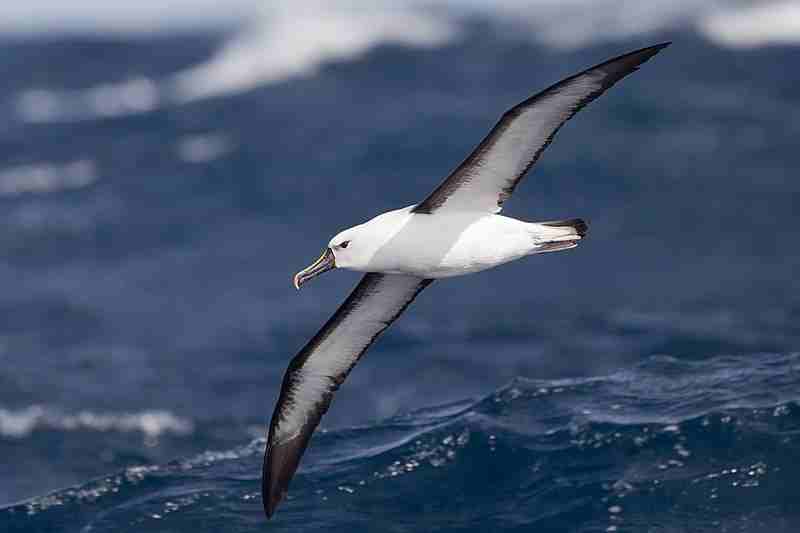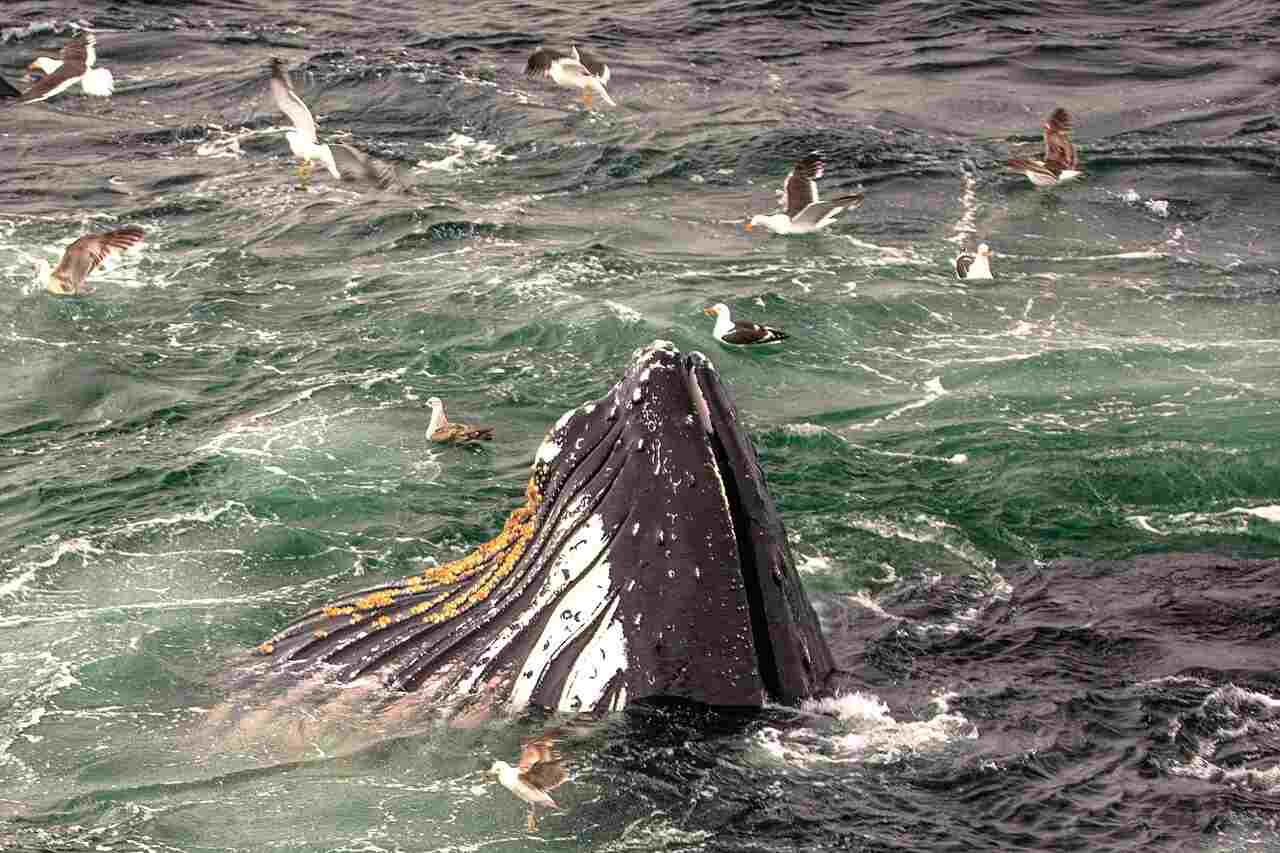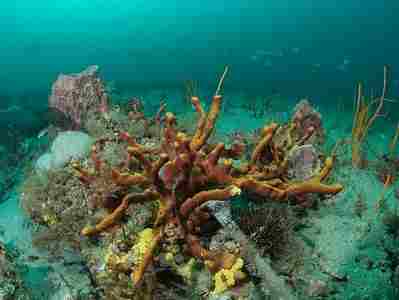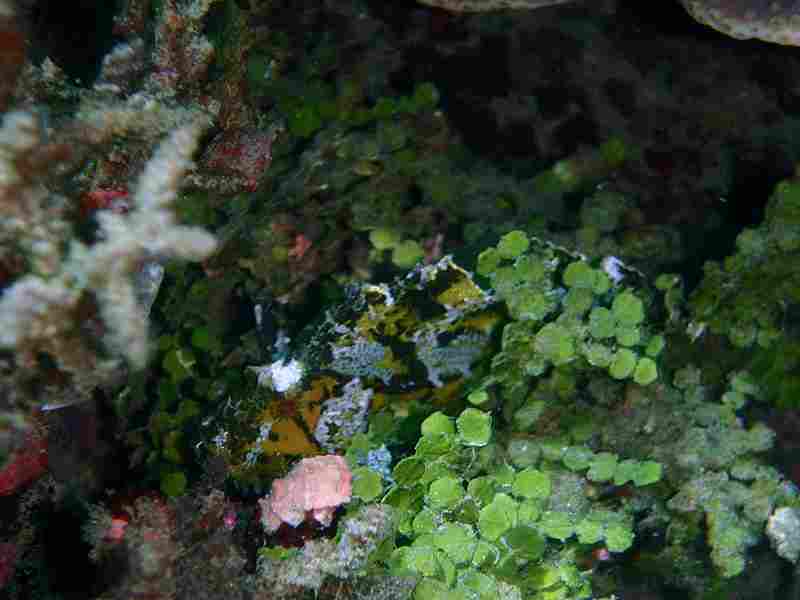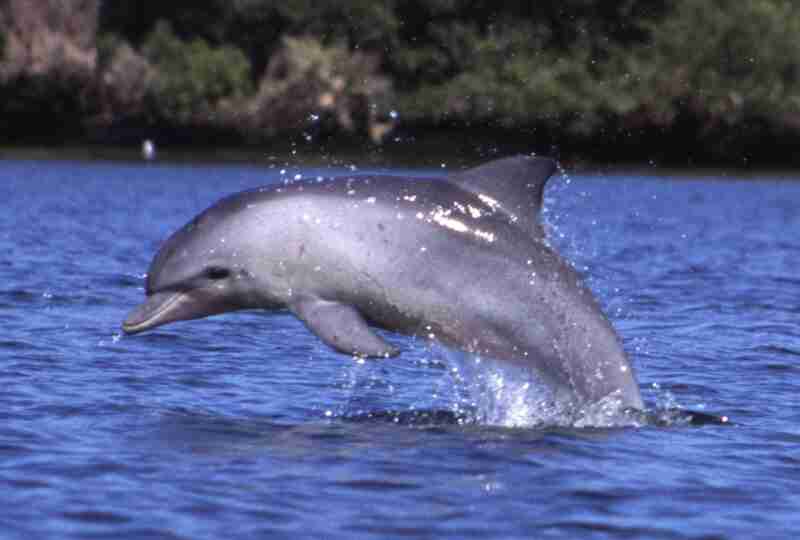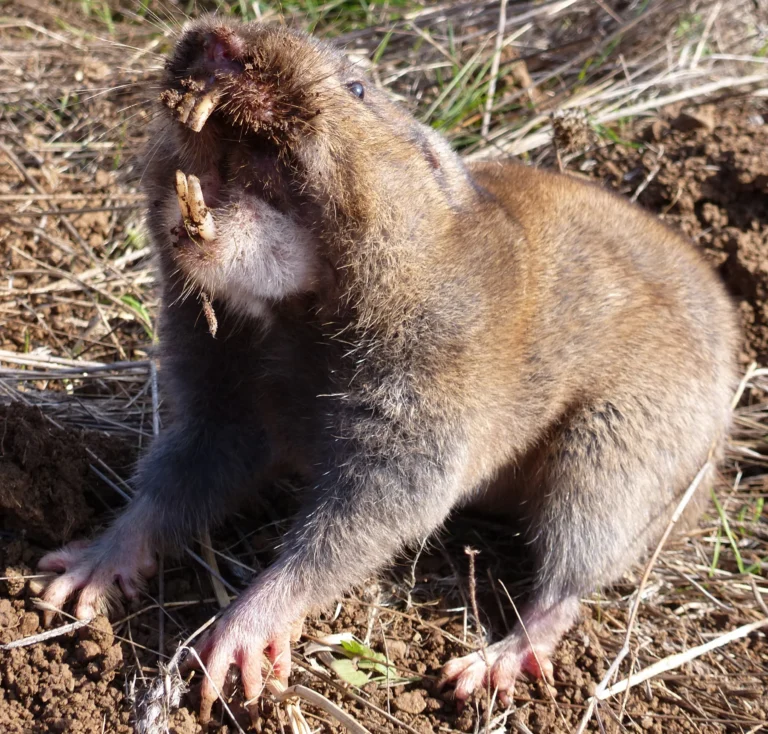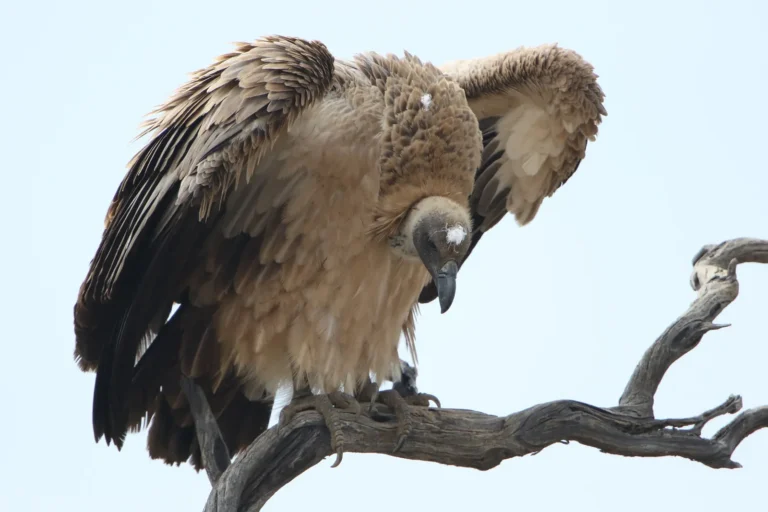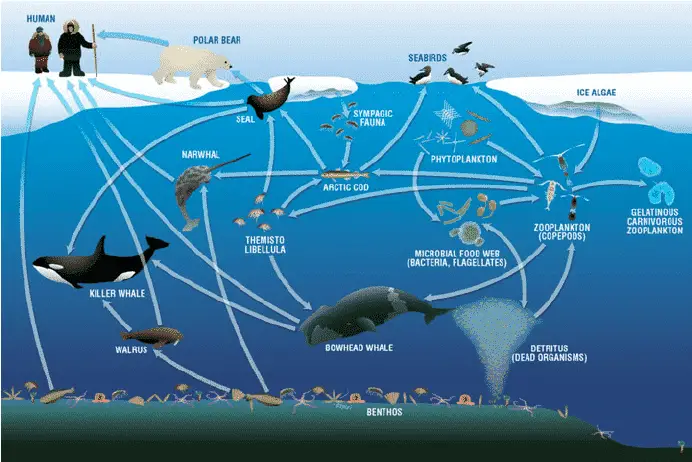Food Chain of the Ocean with Five Trophic Levels Discussed
Food chain of the ocean comprises of producers like phytoplankton and macroalgae; primary consumers like sea turtle, urchin, herbivorous fish and gastropods; secondary consumers like squids, seals and small predatory fish; tertiary consumers like large dolphin and great white shark; quaternary consumers like blue whales and saltwater crocodiles; and decomposers like bacteria, fungi and detrivores.
This article discusses the food chain of the ocean with its trophic levels, organisms and their functions as well as adaptations, as follows;
1). Producers of the Ocean (as part of the Food Chain of the Ocean)
Diverse species of producers occur in the ocean, which are autotrophic organisms that can capture and transform sunlight to biomass and energy, through the process commonly known as photosynthesis [4].
They constitute the basal level or foundation of the food chain/food web of the ocean, from where they supply usable bioenergy (derived from solar energy) to all consumers in the ecosystem that are incapable of photosynthesis.
Examples of producers in the ocean are; macroalgae, phytoplankton, mangrove plants, and seagrasses.
*Macroalgae as a Producer in the Ocean
Macroalgae refer to multicellular algae with macroscopic dimensions, that usually occur in coastal zones within the ocean.
These autotrophs include seaweeds, and grow in attachment to substrata materials like rocks and sediments on the seafloor [9].
Macroalgae are capable of growing to immense sizes, and are crucial as producers of food.
They also help create micro-habitats for several marine organisms.
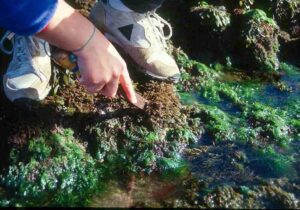
*Phytoplankton as Producers in the Ocean
Phytoplankton are a group of free-floating and microscopic algae that occur abundantly in oceans [3].
These organisms play a huge role in the dynamics of oxygen and carbon cycles in the world; through large-scale, photosynthetic oxygen production and carbon sequestration, respectively.
Organisms that contribute to species richness and diversity among phytoplankton (that is; examples of phytoplankton) are; cyanobacteria, dinoflagellates and diatoms.

Diatoms are versatile, microscopic algae that possess silica shells [5], and may be found in both saline and freshwater-aquatic habitats.
They are important ocean producers and serve as an important source of food for several organisms in their environment.
*Mangrove Plants as Producers in the Ocean
Mangrove plants include shrubs and trees that grow along the coastline in subtropical and tropical zones.
They are wetland-dwellers, and have a series of adaptations which allow them tolerate saline water. Mangrove plants develop intricate root structures for anchorage and gas-exchange in waterlogged soils, and help mitigate erosion in their environment; while serving as an organic micro-habitat.
*Seagrass as a Producer in the Ocean
Seagrasses are a group of angiosperms that thrive mostly in shallow areas of the coast.
These organisms have adaptations for saltwater-tolerance, and are highly productive, so that they play a major role as food sources.
Meadows formed by seagrasses function as shelter and a source of food for several marine species that include turtles, fish, and some invertebrates.
*Comparative Prominence of Producers of the Ocean
The biggest producer in the ocean is phytoplankton, in terms of both photosynthetic capability and rate of biomass production.
Phytoplankton contribute collectively to oxygen production on a global scale, and are responsible for a large portion of oxygen and biomass in their habitat.
Factors behind their prominence include versatility, rapid growth and large population size.
Through their photosynthetic interaction with oxygen and carbon, phytoplankton are instrumental toward the regulation of the Earth's climate.
2). Primary Consumers of the Ocean
Primary consumers in the ocean are heterotrophic organisms that feed directly on producers like macroalgae and phytoplankton, for survival.
These consumers may be found in the second trophic level of the ecologic hierarchy of oceans, where they function as a nutritional bridge between producers and non-herbivorous consumers in higher levels.
Examples of primary consumers in the ocean are; herbivorous fish, sea urchin, zooplankton, sea turtle, filter-feeding bivalves, and herbivorous gastropods.
*Herbivorous Fish as Primary Consumers of the Ocean
Herbivorous fish in the ocean include parrotfish and rabbitfish [11], alongside small schooling herrings and anchovies that consume macroalgae and phytoplankton as a major part of their diet.
The juvenile stage of many fish species rely heavily on phytoplankton for nutrition, to the extent that some of them can correctly be described as herbivores during this stage. In turn, they are prey to larger fish, as well as seabirds and marine mammals.
*Sea Urchin as a Marine Primary Consumer
Sea urchins are a group of marine invertebrates (echinoderms) with spiny morphology, that feed on seagrasses and macroalgae like kelp [6].
Their adaptations for this feeding habit include specialized mouth-parts that enable them graze and scrape algae from the surfaces of rocks.
Sea urchins are important to the regulation of algal populations, which is a crucial function that ensures the sustainability of marine ecosystems.
*Zooplankton as a Primary Consumer of the Ocean
Zooplankton is a term used to describe a variety of small-sized aquatic organisms that occur as drifters or floaters in the water column [13].
They include the larval stage of various aquatic insects, alongside invertebrates like jellyfish, krill and copepods.
Food for zooplankton includes smaller zooplankton, and phytoplankton, which constitute a significant proportion of their diet. They are also a major food source for several larger marine consumers.

*Sea Turtle as a Primary Consumer in the Ocean
Loggerhead turtle and green turtle are two examples of herbivorous sea reptiles.
These turtles consume marine microalgae and seagrasses, and play a role in maintaining the diversity and health of primary consumers which they feed on; while contributing to nutrient-recycling in coastal terrain.
*Filter-Feeding Bivalves as Primary Consumers in the Ocean
Bivalves like clam and mussel are filter-feeders; meaning that they survive by extracting edible organic material from the water column.
Such edible material for bivalves (usually) comprises heavily of phytoplankton, alongside detritus (that include plant remains).
In the process of feeding, these organisms help maintain water quality within their environment. They are also food sources for organisms in higher trophic levels.
*Herbivorous Gastropods as Primary Consumers in the Ocean
Herbivorous gastropods in the marine biome include limpets and some other species of snails.
These organisms consume plant material like algae in coral reefs and on the shore.
Through their feeding, they help regulate the growth of algae and contribute to nutrient-cycling.
3). Secondary Consumers of the Ocean (as part of the Food Chain of the Ocean)
Organisms classified as secondary consumers in the ocean are those that obtain energy by preying on mainly primary consumers.
They occupy the third trophic level of the food chain or energy pyramid, and may occasionally consume fellow secondary consumers that are weaker, outnumbered, slower or smaller.
Through feeding, these organisms are vital to the regulation of primary consumer populations.
Examples of secondary consumers in the ocean are; squids, small predatory fish, seals and sea lions, small sharks, and relatively-large predatory fish like tuna and marlin.
*Small Predatory Fish as Secondary Consumers in the Ocean
Small predatory fish in the ocean include snapper, groupers and cod [7]. They have carnivorous adaptations that enable them prey on other small fish, invertebrates, as well as on some primary producers.

*Squid as a Secondary Consumer in the Ocean
Squids are marine invertebrates that are capable of rapid motion, and can be referred to as secondary consumers.
Adaptive features of the squid include suction cups, beaks, and tentacles for prey capture and consumption [12].
Food for squids consists of crustaceans and small fish, among others.
In turn, consumers in higher trophic levels such as seabirds, whales and sharks, consume squids as an important component of their diet.
*Seals and Sea Lions as Marine Secondary Consumers
Sea lions and seals are closely-related, carnivorous mammals that live in marine environments, and usually function as secondary consumers.
These mammals may consume squids, crustaceans and fish.
Adaptations of sea lions and seals include flippers, excellent swimming capability, fat-layer for insulation, and streamlined morphology for aquatic navigation.
The roles of these animals include population-regulation of their prey; as well as food provision for higher predators like killer whales.

*Small Sharks as Secondary Consumers in the Ocean
While sharks usually function as apex predators within their territory, some smaller species as well as juveniles can be considered secondary consumers.
These animals possess both behavioral and physiological that enable them play their aquatic-predatory role effectively. Examples of their prey are; sea turtles, seals and fish; whose population dynamics are influenced by the sharks' predatory behavior.
*Relatively-Large Predatory Fish as Secondary Consumers in the Ocean
Tuna and marlin are predatory fish that are typically larger than their smaller counterparts like the snapper (asides the cubera snapper, which can grow to exceptionally-large sizes [8]).
Species of tuna fish, like the skipjack and yellowfin tunas, are important as marine secondary consumers.
Their adaptive features include streamlined bodies, excellent swimming capability, and migratory behavior; all of which enable them to sustain their carnivorous diet all year round.
Food for the tuna includes squids; crustaceans and smaller fish. They are also a source of food, and have economic value as an aquacultural commodity.
The striped marlin and blue marlin are both large, predatory fish that function as secondary consumers in the ocean. They can be classified as tertiary consumers in some cases due to their sheer size, especially where larger and more powerful predators are not prominent.
Features of marlins that make them efficient predators include; streamlined, elongate bodies, sharp bills and powerful tails, all of which enable them capture various kinds of prey.
Food for the marlin consists of squids and smaller fish, among others.
*Overview of Secondary Consumers in the Pacific Ocean
Examples of secondary consumers in the Pacific Ocean are;
1. Small sharks
2. Tuna
3. Indo-Pacific blue marlin
4). Tertiary Consumers of the Ocean
Tertiary consumers in the ocean can be found in the fourth trophic level of the food chain.
They are mostly predatory organisms, that are capable of feeding on both primary and secondary consumers, as well as on vulnerable, fellow tertiary consumers.
Through their activities, tertiary consumers contribute to the maintaining of marine ecologic balance, and the regulation of organic populations in lower trophic levels.
It must be noted that the fourth trophic level for tertiary consumers, is often the apex-predator level of the food chain. However, in ecosystems with an exceptionally-high level of organic speciation and biodiversity (as is the case for many oceans), a fifth trophic level can be distinguished, so that tertiary consumers are no longer apex predators of the food chain.
Examples of tertiary consumers in the ocean are; exceptionally-large tuna, great white shark, and large dolphins,
*Exceptionally-Large Tuna as a Tertiary Consumer in the Ocean
Some tuna species are capable of growing to exceptional large sizes.
These include the bluefin tuna, which can be classified as a tertiary consumer in the absence of notable representation of larger predators.
Bluefin tuna is known for its speed and hunting skill, which enable it capture equally-fast prey.
Food for large tuna species includes squids, crustaceans and fish.
*Great White Shark as a Tertiary Consumer in the Ocean
The great white shark is one of the most well-known ans iconic predators of the ocean; which often functions as an apex within its territory (it may fall lower than the apex level in the face of larger and more competitive regional predators).
Adaptations of great white sharks include rows of numerous sharp teeth, significant speed, acute sensitivity, and powerful jaws.
Their prey include sea lions and seals, as well as fish.
Activities of great white sharks help to maintain equilibrium of energy-transfer in the marine biome.

*Large Dolphins as Tertiary Consumers in the Ocean
Some species of large dolphins including individuals from the bottleneck dolphin category, can be classified as tertiary consumers of the ocean. It must also be noted within this context that the orca or killer whale is a large specie of dolphin [2], and yet one of the well-known apex predators in the ocean alongside baleen whales.
Large dolphins are highly-evolved mammals that have a fairly diverse diet including squids, other marine mammals, and fish.
Their social behaviors and hunting skills enable these mammals to play a crucial role in the maintenance of marine populations.
*Quaternary Consumers as an Advancement from Tertiary Consumers in the Ocean
Quaternary consumers are discussed in the subsequent section of this article, as organisms that can prey on (and/or are more biologically advanced as predators than) tertiary consumers.
Where they are included in the food chain, quaternary consumers are apex predators that influence the population dynamics of all other consumers in their environment, including primary, secondary and tertiary groups.
5). Quaternary Consumers, at the Top of the Food Chain of the Ocean (as part of the Food Chain of the Ocean)
Quaternary consumers are occupants of the highest trophic level in the ocean food chain; meaning that they are better-equipped as predators than even tertiary consumers.
They quaternary consumers have significant influence over the populations of all organic groups beneath them in the food chain.
Examples of animals that can be classified as tertiary consumers in the ocean are; blue whales, saltwater crocodiles, polar bears, and aquatic 'raptors' like kingfishers and albatrosses.
While these organisms are not all exceptionally large or powerful, they each have characteristics that place them at an advantage compared to other individuals in their environment; such as keen sensitivity and flight-capability.
When discussing consumers at any level of the food chain, it must be noted that the position of these consumers is case-specific, and usually depends on the species-richness of (and the nature of other consumers in) their environment.

6). Decomposers in the Ocean
Decomposers in the ocean are organisms whose metabolic activities facilitate biodegradation and conversion of organic matter to inorganic minerals/nutrients that can be recycled in the ecosystem [10].
In the food chain of the ocean, decomposers are not confined to any particular trophic level, but rather act on the remains of organisms from all trophic levels, including other decomposers.
Examples of decomposers in the ocean are; fungi, bacteria and detrivores.
*Fungi as Decomposers in the Ocean
Fungi are a notable group of microbes that are responsible for the breakdown of organic matter in oceans.
Organic materials that are decomposed by fungi include animal remains, algal matter, and vascular plant materials, as well as organic detritus.
Fungi cause organic matter degradation by secreting enzymes that enable them absorb nutrients from complex organic compounds [1]. Their activities are vital to the cycling of nutrients in marine environments.
*Bacteria as Decomposers in the Ocean
Bacteria are arguably the most-widespread decomposers in the ocean, and are both crucial and effective in their nutrient-cycling role.
They act on organic materials like planktonic, algal, and heterotrophic remains, which they breakdown into simpler, absorbable forms that can be assimilated back into the food chain.
*Detrivores in the Ocean
Detrivores are organisms that feed on organic remains, especially in the form of litter or detritus; and accelerate the breakdown of such organic materials in the process.
Detritus, which is a primary substrate of these organisms, comprises of partially-decomposed organic matter, which the detrivores cause to degrade further into simpler components.
Examples of detrivores in the ocean are; worms, sea cucumbers; some mollusks, and crustacean-scavengers like isopods and amphipods.

*Summary of the Role of Decomposers in the Ocean
The core role of decomposers in the ocean food chain is to degrade complex organic materials and transform them to simpler nutrients that are recycled back into the energy-transfer sequence.
Remains of dead marine organisms typically sink to the floor of the ocean, or may float within the water column. These remains serve as a food source for detrivores, who break them down into simpler materials and nutrients like phosphorus, carbon and nitrogen that are released into the wafer to be taken up subsequently by primary producers.
Conclusion
The food chain of the ocean comprises of;
1. Producers like phytoplankton and macroalgae
2. Primary Consumers like sea turtle, urchin, herbivorous fish and gastropods
3. Secondary Consumers like squids, seals and small predatory fish
4. Tertiary Consumers like large dolphin and great white shark
5. Quaternary Consumers like blue whales and saltwater crocodiles
6. Decomposers like bacteria, fungi and detrivores
References
1). Alekseyeva, K. S.; Herndl, G. J.; Baltar, F. (2022). "Extracellular Enzymatic Activities of Oceanic Pelagic Fungal Strains and the Influence of Temperature." Journal of Fungi — Open Access Mycology Journal 8(6). Available at: https://doi.org/10.3390/jof8060571. (Accessed 26 June 2023).
2). Chwalibog, A.; Kachar, M.; Sawosz, E. (2018). "Orcas are social mammals." Available at: https://doi.org/10.15406/ijawb.2018.03.00101. (Accessed 26 June 2023).
3). Falkowski, P. G. (2002). "The ocean's invisible forest." Sci Am. 2002 Aug;287(2):54-61. Available at: https://doi.org/10.1038/scientificamerican0802-54. (Accessed 26 June 2023).
4). Ghosh, T.; Mishra, S. (2017). "How Does Photosynthesis Take Place in Our Oceans?" Frontiers for Young Minds 5(34). Available at: https://doi.org/10.3389/frym.2017.00034. (Accessed 26 June 2023).
5). Hildebrand, M.; Lerch, S. J. L.; Shrestha, R. (2018). "Understanding Diatom Cell Wall Silicification—Moving Forward." Frontiers in Marine Science 5. Available at: https://doi.org/10.3389/fmars.2018.00125. (Accessed 26 June 2023).
6). Nichols, K. D.; Segui, L. M.; Hovel, K. A. (2015). "Effects of predators on sea urchin density and habitat use in a southern California kelp forest." Marine Biology 162(6). Available at: https://doi.org/10.1007/s00227-015-2664-2. (Accessed 26 June 2023).
7). Nuraini, S.; Carballo, E.; van Densen, W.; Machiels, M. A. M.; Lindeboom, H. J.; Nagelkerke, L. A. J. (2007). "Utilization of seagrass habitats by juvenile groupers and snappers in Banten Bay, Banten Province, Indonesia." Hydrobiologia 591(1):85-98. Available at: https://doi.org/10.1007/s10750-007-0786-3. (Accessed 26 June 2023).
8). Sanches, E. G.; Costa, W.; Vilani, Fg.; Krueger, Dm.; Passini, G.; Cerqueira, Vr. (2012). "First occurrence of cubera snapper Lutjanus cyanopterus (Cuvier, 1828) in the southern Brazilian coast." Brazilian journal of biology = Revista brasleira de biologia 72(4):963-5. Available at: https://doi.org/10.1590/S1519-69842012000500026. (Accessed 26 June 2023).
9). Sangha, J.; Kelloway, S.; Critchley, A. T.; Prithiviraj, B. (2014). "Seaweeds (Macroalgae) and Their Extracts as Contributors of Plant Productivity and Quality: The Current Status of Our Understanding." Elsevier. Available at: https://doi.org/10.1016/B978-0-12-408062-1.00007. (Accessed 26 June 2023).
10). Sridhar, K. R. (2012). "Decomposition of materials in the sea." Marine Fungi and Fungal-like Organisms, (pp.475-500). Available at: https://doi.org/10.1515/9783110264067.475. (Accessed 26 June 2023).
11). Streit, R.; Hoey, A. S.; Bellwood, D. R. (2015). "Feeding characteristics reveal functional distinctions among browsing herbivorous fishes on coral reefs." Coral Reefs 34(4):1-11. Available at: https://doi.org/10.1007/s00338-015-1322-y. (Accessed 26 June 2023).
12). Vidal, E. A. G.; Salvador, B. (2019). "The Tentacular Strike Behavior in Squid: Functional Interdependency of Morphology and Predatory Behaviors During Ontogeny." Front Physiol. 2019 Dec 31;10:1558. Available at: https://doi.org/10.3389/fphys.2019.01558. (Accessed 26 June 2023).
13). Wokoma, O. A. F. (2016). "Zooplankton Species Composition and Abundance in the Brackish water axis of Sombreiro River, Niger Delta." Available at: https://www.academia.edu/33309126/Zooplankton_Species_Composition_and_Abundance_in_the_Brackish_water_axis_of_Sombreiro_River_Niger_Delta. (Accessed 26 June 2023).
